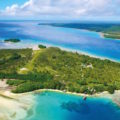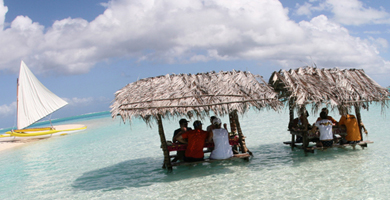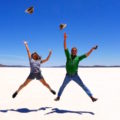COOK ISLANDS: Crossing The Dateline to Rarotonga
British expat, Alan Curson, sheds his winter woollies and his watch to embrace the warmth and freedom of the South Pacific.
Before I moved to Australia, all the Aussies I knew in London helpfully advised me that it never gets cold enough in Sydney, even in the middle of winter, to warrant more than a thin jacket or a lightweight jumper. They lied. Having discovered the truth about Sydney’s chilly winter through teeth-chattering experience, my wife and I decided we needed some real sunshine and headed for the Cook Islands.
We left a wet Sydney on a Tuesday evening, flew through the night (6 hours) on a direct Air New Zealand flight and oddly landed in Rarotonga at 7AM on the morning of the same day we set out. And as if crossing an international dateline en route isn’t baffling enough, we were soon serenaded by a man with a ukulele as the bags went round the luggage carousel and a sniffer dog checked us out for drugs and sausages. We were then garlanded with leis of powerfully scented frangipanis and whisked off to our new digs. I think it was less than an hour from landing to sitting in the beach bar area of the Aroa Beachside Inn and enjoying a pleasant light breakfast of local fruit and home made muffins as the sun began to work its magic on us.
Rarotonga may be the largest of the fifteen Cook Islands but it actually has a circumference of just 21 miles and takes less than an hour to drive around. There is a coral reef around most of it and a continuous roar of surf as the ocean crashes into it. Meanwhile, island side of the reef, the water is calm, shallow, warm and teeming with all kinds of brightly colored fish – a brilliant place to explore with a snorkel and mask.
We found the best way to get around and see the island was on scooters which are easy enough to hire, although you’ll need to get a Cook Islands license which is a relatively straightforward process and will set you back $20 NZ at the police station in Avarua. You can also get around perfectly well by bus. They have a clockwise and an anti clockwise service so one way or the other, you can get where you’re going and the longest you’ll ever have to wait is half an hour. It’s hard to get lost on Rarotonga’s roads – there are basically only two of them. One goes round the outside of the island and the other goes round the inside for most of the way round. Most of the places to stay are beach side of the outer road, but we found a lot of interesting things on the inner road too. There was the prison, which owing to the almost complete absence of crime on the island, isn’t exactly the busiest of places. Here, there’s a craft shop where you can buy ukuleles hand made by the inmates. Not far from the prison is the Cook Islands Whale Education Centre run by Nan Hauser, which is well worth a visit. There’s also a perfume factory where you can buy locally made perfumes, not to mention an abundance of the Cook Island’s famous black pearls.
More through luck than planning, we arrived during Constitution Week, which is when the islanders celebrate self-government. (The islands have been self-governing, in free association with New Zealand, since 1965.) The Cook islanders are proud Maoris and to our eyes, their culture seemed like a combination of high art and competitive sport. The week-long celebrations consisted of teams from each of the islands and villages competing with each other in the excellent auditorium in Avarua. Cheered on by an enthusiastic and knowledgeable packed house, they competed in front of a panel of judges for the best Maori chants, the best Maori dancing, the best Maori singing and the best Maori drumming. I can’t say we really understood the finer points of what we saw, but it was magnificent to watch and the singing was glorious. That same week, there was a hotly contested inter-island rugby sevens competition and as rugby is almost a religion in the Cook Islands, the standard was really high.
 Sunset at the beach bar of the Aroa Beachside Inn, on the west side of the island, is a must. The eccentric and highly entertaining owner Jim and his partner Jan, are great hosts and their twice-weekly barbecues are fantastic value at $25 NZ a head for food and entertainment. There is live music – ukulele based naturally – provided by Rou and the Boys (a father and sons trio) on one night and Rudy Aquino (uniquely gifted on the vibro harp) on the other night. Barbecue nights are popular so you need to book in ahead of time. Another character here worth a mention is the resident dog. He takes a keen interest in all the guests and will often accompany them on walks along the beach. He even came into the lagoon with us once, stopping here and there for a spot of fishing (apparently, he sometimes does catch a fish). The rooms at the Inn are spacious, comfortable and equipped with kitchens and TVs. So you can self cater and even watch local TV if you must. There are only two stations though – a religious channel and one with soaps from New Zealand. (The local TV ads are fun though.)
Sunset at the beach bar of the Aroa Beachside Inn, on the west side of the island, is a must. The eccentric and highly entertaining owner Jim and his partner Jan, are great hosts and their twice-weekly barbecues are fantastic value at $25 NZ a head for food and entertainment. There is live music – ukulele based naturally – provided by Rou and the Boys (a father and sons trio) on one night and Rudy Aquino (uniquely gifted on the vibro harp) on the other night. Barbecue nights are popular so you need to book in ahead of time. Another character here worth a mention is the resident dog. He takes a keen interest in all the guests and will often accompany them on walks along the beach. He even came into the lagoon with us once, stopping here and there for a spot of fishing (apparently, he sometimes does catch a fish). The rooms at the Inn are spacious, comfortable and equipped with kitchens and TVs. So you can self cater and even watch local TV if you must. There are only two stations though – a religious channel and one with soaps from New Zealand. (The local TV ads are fun though.)
There are plenty of places to eat out and we didn’t have a bad experience in any of them, although prices seemed a little high in general until we discovered gems like the Game Fishing Club on the north of the island where they serve delicious fish and chips for about $10 NZ from a converted boat – you can sit and eat them just a few feet away from the water’s edge. Another place we liked was the Ariki Café, which is reasonably priced, run by locals and tucked away on the inner road not far from the bus terminus. Here, they serve desserts to die for (the servings are dangerously massive). We didn’t find any late night nightlife although rumor has it Trader Jack’s in Avarua is open quite late. But as the island has a considerably larger chicken population than it does human, dawn can be pretty noisy. So late nights aren’t really a big part of the ethos here. If you are looking for block rocking beats and club culture, the Cook Islands probably aren’t for you. Apart from exploring, sunbathing, snorkeling, swimming, eating, drinking, meeting very nice people (locals and visitors) and generally chilling out, there is not a whole lot to do, thankfully. That said, we did manage to mosey through the Punanga Nui market (open every Saturday). Sadly, it was the one and only day we had in Rarotonga when it rained. We got soaked (not a problem as it was nice warm rain), but most of the people running market stalls gave it a miss so we didn’t get to see everything. I’m told it’s really interesting so if you get the chance, go have a wander. (Just steer clear of the local Noni juice.)
 Religion is central to island life, so we even went to church. There are several brands of Christianity to choose from with churches all over the place and on Sundays you’ll have services coming out of your ears. We went to the morning service just down the road from Aroa Beach and I defy even the most cynical of non-believers not to have been a little awed by the experience. The singing was spectacular and the local congregation incredibly welcoming. We had tea and sandwiches and cakes pressed on us in huge quantities after the service.
Religion is central to island life, so we even went to church. There are several brands of Christianity to choose from with churches all over the place and on Sundays you’ll have services coming out of your ears. We went to the morning service just down the road from Aroa Beach and I defy even the most cynical of non-believers not to have been a little awed by the experience. The singing was spectacular and the local congregation incredibly welcoming. We had tea and sandwiches and cakes pressed on us in huge quantities after the service.
Our sailing trip was with a British lady called Beth who skippers the Tropical Bird – a trimaran moored in the harbor near Avarua. As we set off, Beth was in radio contact with Nan Hauser from the Whale Education Centre who just happened to be out on the ocean photographing a whale and its 3 day-old calf, and invited us over for a look. We spent a very pleasant hour or so watching them both. Nan Hauser and her team are the main driving force behind the establishment of a 2 million square mile whale sanctuary around the Cook Islands.
After a few days exploring the island, we hopped on a domestic Rarotonga Airlines flight to Aitutaki, which is basically a huge lagoon with some sand and palm trees attached. From the air, the lagoon is spectacular – the varieties of stunning, impossible blues are hard to believe. We ventured out on an organized tour of the lagoon, which lasted all day. We snorkeled with every color of fish imaginable, fed a giant trevallen (a big fish that likes eating white bread), came face to face with a beautiful, but rather sinister Moray eel to shouts of “swim away from the Moray eel” from our tour leader. Easier said than done! We also saw coral of many different kinds and colors – blues, green, orange, red, purple – there was even one that changed color from purple to blue as you got closer, not to mention the delicate orange Christmas Tree coral that just dazzles. But don’t be deceived, the abundance of live coral here doesn’t hide the fact that in many places (including Aitutaki) the coral is dying or has already died. The locals blame many things for this, but mostly they believe it’s chemical pollution from industrial scale agriculture, which used to be practiced on the island, and wild weather caused by global warming. Whatever the cause, it’s a reminder that these islands are tiny and they have finely balanced ecosystems, which are incredibly easy to upset at great cost to all of us.
We spent two nights on Aitutaki before catching a very relaxed flight back to Rarotonga. The co-pilot spent much of the journey catching up with all the sport in the local paper. There was no room at the Aroa Beachside Inn for our last two nights (they were fully booked), but they suggested a place called Tropical Sands at the other end of the island where the reef is just a stone’s throw away and the roar of the ocean beyond is fantastic. Sometimes whales breach so close you almost feel you could reach out and touch them. Tropical Sands is run by the musician Rudy Aquino and his artist wife Kanoe. The place is a beautiful haven of calm – if transcendental meditation were a place this would be it. And Rudy and Kanoe couldn’t be more welcoming. For those on a bigger budget, the Little Polynesian is one of the Cook Island’s best boutique hotels. Sadly however, that was the end of our Rarotonga adventure.
On the flight back to Sydney, it occurred to me that the reason we enjoyed Rarotonga so much is that it is still pretty much its own place. It hasn’t been ruined by the madness of the tourism industry… yet. There is a chance that the Cook Islands might hold on to their beautiful identity. They are self-governing and only Cook Islanders can own land there (foreigners can buy 60 year leases, but the freehold stays with the islanders). And so far no buildings are higher than the trees. The local people have a friendly, openness. They are very proud and protective of their islands, but they also like to show them off and are happy to share them with us. But tourism is their most important industry and already, the restaurants and guesthouses seem to be predominantly run by expat Brits, Kiwis and Aussies. As far as we could see, all these business interests appear to treat the island and its culture with respect and admiration. But it’s a delicate balance and the locals need to take care that their paradise never sells out because that would defeat the whole point of the place. Kia Orana! (Long may you live.)
For more information visit www.cookislands.travel or www.airnewzealand.com.au
Latest posts by Alan Curson
- COOK ISLANDS: Crossing The Dateline to Rarotonga - October 6, 2011









